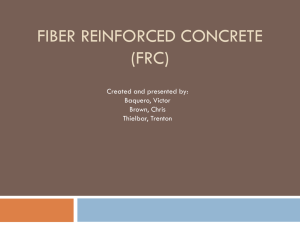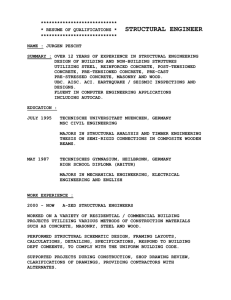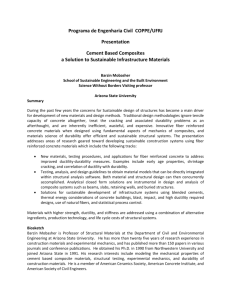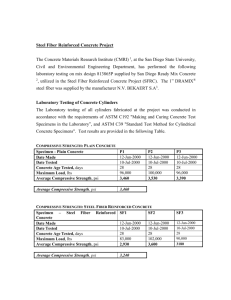Document 10285002
advertisement
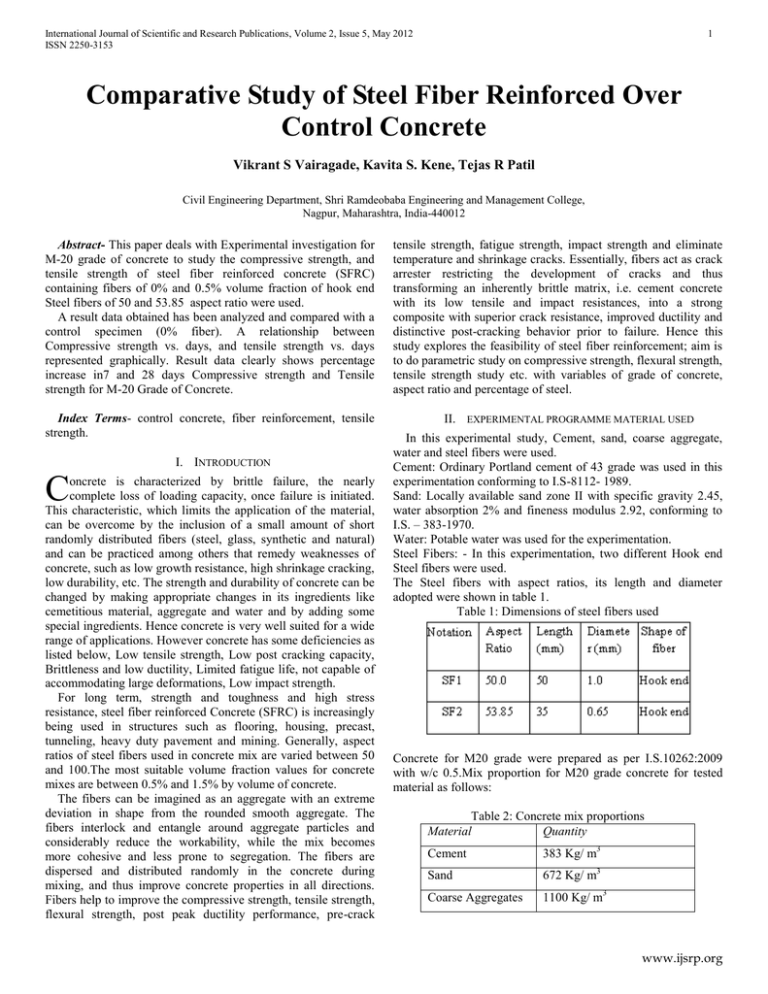
International Journal of Scientific and Research Publications, Volume 2, Issue 5, May 2012 ISSN 2250-3153 1 Comparative Study of Steel Fiber Reinforced Over Control Concrete Vikrant S Vairagade, Kavita S. Kene, Tejas R Patil Civil Engineering Department, Shri Ramdeobaba Engineering and Management College, Nagpur, Maharashtra, India-440012 Abstract- This paper deals with Experimental investigation for M-20 grade of concrete to study the compressive strength, and tensile strength of steel fiber reinforced concrete (SFRC) containing fibers of 0% and 0.5% volume fraction of hook end Steel fibers of 50 and 53.85 aspect ratio were used. A result data obtained has been analyzed and compared with a control specimen (0% fiber). A relationship between Compressive strength vs. days, and tensile strength vs. days represented graphically. Result data clearly shows percentage increase in7 and 28 days Compressive strength and Tensile strength for M-20 Grade of Concrete. Index Terms- control concrete, fiber reinforcement, tensile strength. I. INTRODUCTION C oncrete is characterized by brittle failure, the nearly complete loss of loading capacity, once failure is initiated. This characteristic, which limits the application of the material, can be overcome by the inclusion of a small amount of short randomly distributed fibers (steel, glass, synthetic and natural) and can be practiced among others that remedy weaknesses of concrete, such as low growth resistance, high shrinkage cracking, low durability, etc. The strength and durability of concrete can be changed by making appropriate changes in its ingredients like cemetitious material, aggregate and water and by adding some special ingredients. Hence concrete is very well suited for a wide range of applications. However concrete has some deficiencies as listed below, Low tensile strength, Low post cracking capacity, Brittleness and low ductility, Limited fatigue life, not capable of accommodating large deformations, Low impact strength. For long term, strength and toughness and high stress resistance, steel fiber reinforced Concrete (SFRC) is increasingly being used in structures such as flooring, housing, precast, tunneling, heavy duty pavement and mining. Generally, aspect ratios of steel fibers used in concrete mix are varied between 50 and 100.The most suitable volume fraction values for concrete mixes are between 0.5% and 1.5% by volume of concrete. The fibers can be imagined as an aggregate with an extreme deviation in shape from the rounded smooth aggregate. The fibers interlock and entangle around aggregate particles and considerably reduce the workability, while the mix becomes more cohesive and less prone to segregation. The fibers are dispersed and distributed randomly in the concrete during mixing, and thus improve concrete properties in all directions. Fibers help to improve the compressive strength, tensile strength, flexural strength, post peak ductility performance, pre-crack tensile strength, fatigue strength, impact strength and eliminate temperature and shrinkage cracks. Essentially, fibers act as crack arrester restricting the development of cracks and thus transforming an inherently brittle matrix, i.e. cement concrete with its low tensile and impact resistances, into a strong composite with superior crack resistance, improved ductility and distinctive post-cracking behavior prior to failure. Hence this study explores the feasibility of steel fiber reinforcement; aim is to do parametric study on compressive strength, flexural strength, tensile strength study etc. with variables of grade of concrete, aspect ratio and percentage of steel. II. EXPERIMENTAL PROGRAMME MATERIAL USED In this experimental study, Cement, sand, coarse aggregate, water and steel fibers were used. Cement: Ordinary Portland cement of 43 grade was used in this experimentation conforming to I.S-8112- 1989. Sand: Locally available sand zone II with specific gravity 2.45, water absorption 2% and fineness modulus 2.92, conforming to I.S. – 383-1970. Water: Potable water was used for the experimentation. Steel Fibers: - In this experimentation, two different Hook end Steel fibers were used. The Steel fibers with aspect ratios, its length and diameter adopted were shown in table 1. Table 1: Dimensions of steel fibers used Concrete for M20 grade were prepared as per I.S.10262:2009 with w/c 0.5.Mix proportion for M20 grade concrete for tested material as follows: Table 2: Concrete mix proportions Material Quantity Cement 383 Kg/ m3 Sand 672 Kg/ m3 Coarse Aggregates 1100 Kg/ m3 www.ijsrp.org International Journal of Scientific and Research Publications, Volume 2, Issue 5, May 2012 ISSN 2250-3153 Water 192 Kg/ m3 Steel Fibers 0.5% by volume of concrete Slump 75-100 mm 2 III. EXPERIMENTAL METHODOLOGY a) Compressive Strength Test: For compressive strength test, both cube specimens of dimensions 150 x 150 x 150 mm and cylindrical specimens of length 200 mm and diameter 100 mm were cast for M20 grade of concrete. The moulds were filled with 0% and o.5% fibers. Vibration was given to the moulds using table vibrator. The top surface of the specimen was leveled and finished. After 24 hours the specimens were demoulded and were transferred to curing tank where in they were allowed to cure for 7 days and 28 days. After 7 and 28 days curing, these cubes and cylinders were tested on digital compression testing machine as per I.S. 516-1959. The failure load was noted. In each category, three cubes and three cylinders were tested and their average value is reported. The compressive strength was calculated as follows: Compressive strength (MPa) = Failure load / cross sectional area. b) Tensile strength test: For tensile strength test, cylinder specimens of dimension 100 mm diameter and 200 mm length were cast. The specimens were demoulded after 24 hours of casting and were transferred to curing tank where in they were allowed to cure for 7 and 28 days. These specimens were tested under compression testing machine. In each category, three cylinders were tested and their average value is reported. Tensile strength was calculated as follows as split tensile strength: Tensile strength (MPa) = 2P / π DL, Where, P = failure load, D = diameter of cylinder, L = length of cylinder. Figure 1: Compressive strength using cube Figure.1 indicates the comparison of result of compressive strength using cube specimen of M20 grade of concrete. It is observed that for addition of 0.5% Fiber SF1 gives slightly more compressive strength than SF2 at same volume fraction. A) Using cylindrical Specimen: Results of Compressive strength for M-20 grade of concrete on cylinder specimen with 0% and 0.5% steel fibers for aspect ratio 50 and 53.85 are shown in table and Figure below: Table 4: Results of Compressive strength using cylinder specimen IV. EXPERIMENTAL RESULTS 1) Compressive Strength Test: A) Using cube Specimen: The compressive strength test is consider the most suitable method of evaluating the behavior of steel fiber reinforced concrete for underground construction at an early age, because in many cases such as in tunnels, steel fiber reinforced concrete is mainly subjected to compression [8] Results of Compressive strength for M-20 grade of concrete on cube and cylinder specimen with 0% and 0.5% steel fibers for aspect ratio 50 and 53.85 are shown in table and graph below: Table3: Results of Compressive strength using cubes specimen Figure2: Compressive strength using cylinder Figure.2 indicates the comparison of result of compressive strength using cylindrical of M20 grade of concrete. It is observed that for addition of 0.5% Fiber SF1 gives slightly more compressive strength than SF2 at same volume fraction. b) Tensile strength test: www.ijsrp.org International Journal of Scientific and Research Publications, Volume 2, Issue 5, May 2012 ISSN 2250-3153 Results of splitting tensile strength for M-20 grade of concrete with 0% and 0.5% steel fibers for aspect ratio 50 and 53.85 are shown in table and Figure below: 3 concrete can be overcome by using suitable admixtures such as Superplasicizers. REFERENCES Table5: Results of splitting tensile strength using cylinder. Days [1] Average Split Tensile Strength (Mpa) 0% 0.5 % (SF1) 0.5 % (SF2) 7 1.26 1.62 1.41 28 2.12 2.87 2.32 [2] [3] [4] [5] [6] [7] [8] Figure 3: Comparison of Split tensile strength Figure 3 indicates the result for M20 grade of concrete. It is observed that for addition of 0.5% SF2 fiber gives maximum tensile strength at 28 days. [9] [10] [11] [12] V. DISCUSSION The study on the effect of steel fibers with different sizes can still be a promising work as there is always a need to overcome the problem of brittleness of concrete. The following conclusions could be drawn from the present investigation1. It is observed that the compressive strength for M20 grade of concrete from two different dimensional fibers at same volume fraction shows nearly same results with minor increase. 2. By addition of 0.5% hook end steel fibers increases compressive strength of concrete up to 10%. 3. With same volume fraction, change in dimensional properties of fiber result nearly minor effect on compressive strength of Fiber Reinforced concrete. 4. It is observed that, the split tensile strength of fiber reinforced concrete was dependent on length of fiber used. By addition of longer length fiber, the split tensile strength increases. Used of 50 mm long fiber with same volume of fraction gives 20% extra split tensile strength over fiber 35 mm in length. 5. Addition of steel fiber in the concrete effect the workability of concrete. Addition of 0.5% steel fiber reduces the slump value of fresh concrete. This problem of workability and flow property of [13] R. D. Neves and J. C. O Fernandes de Almeida (2005), “Compressive behavior of steel fiber reinforced concrete”, Concrete Division, Lisbon, Portugal Surendra P. Shah, Bruce Ankenman,and Alan F. Karr, “Permeability of Cracked Steel Fiber-Reinforced Concrete”, National Institute of Statistical Sciences Research Triangle Park Ganeshan N et al, (2007), Steel fiber reinforced high performance concrete for seismic resistant structure, Civil Engineering and construction Review, December 2007, pp 54-63 Bhikshma V, Ravande Kishor and Nitturkar Kalidas (2005), Mechanical properties of fiber reinforced high strength concrete, Recent advances in concrete and construction tech‟6-8 Jan 2005, Chennai, pp 23-33 Murthy Dakshina N R (2005) “Splitting tensile strength of high volume fly ash concretes with and without steel fibers in different grades “International conference recent advance on concrete and construction technology, Dec 7-9,2005, Balaguru P and Najm H (2004), “High-performance fiber reinforced concrete mixture proportion with high fiber volume fractions” Material Journal, volume 101, issue 4, July 1, 2004 pp281-286, Tensing D,Jeminah and Jaygopal L S (2003) “ Permeability studies on steel fiber reinforced concrete and influence of fly ash”. National seminar on advance in construction materials, 14-15 Feb. 2003 Tensing D, Jeminah and Jaygopal L S (2003) “Permeability studies on steel fiber reinforced concrete and influence of fly ash” National seminar on advance in construction materials, 14-15 Feb. 2003 IS 383:1970, Specification for coarse and fine aggregates from natural sources for concrete (second revision), Bureau of Indian standards, New Delhi, India. IS: 10262-2009, Recommended guidelines for concrete mix design, Bureau of Indian standards, New Delhi, India IS: 516-1959, Indian standard methods of tests for strength of concrete, Bureau of Indian Standards, New Delhi, India. Job Thomas and Ananth Ramaswamy (2007), “Mechanical Properties of Steel Fiber-Reinforced Concrete”, Journal of Material in Civil Engineering, 19(5), pp.385-392 Hehua Zhu et al.( 2006), “Numerical Analysis and Field Test on Performance of Steel Fiber Reinforced Concrete Segment in Subway Tunnel”, Proceedings of Sessions of Geo Shanghai, Editors Shanghai, China AUTHORS First Author: Vikrant S. Vairagade, M-Tech (Struct), Shri Ramdeobaba college of Engineering and Management, Nagpur, Maharashtra, India-440012 E-mail ID:-vikrantvairagade@gmail.com Second Author: Kavita S Kene, M-tech(Structural), Shri Ramdeobaba college of Engineering and Management, Nagpur, Maharashtra, India-440012 E-mail ID:-kavitakene@gmail.com Third Author: Tejas R Patil,M-tech(Structural Eng), Shri Ramdeobaba college of Engineering and Management, Nagpur, Maharashtra, India-440012, E-mail ID:-patil.tejas507@gmail.com www.ijsrp.org



